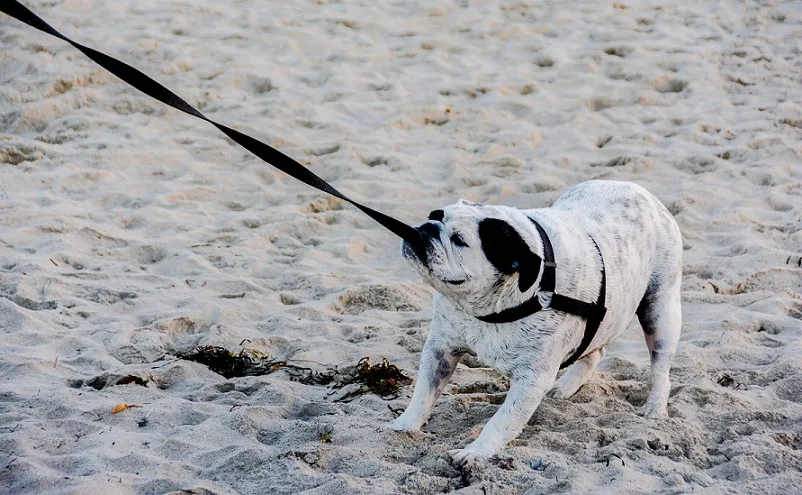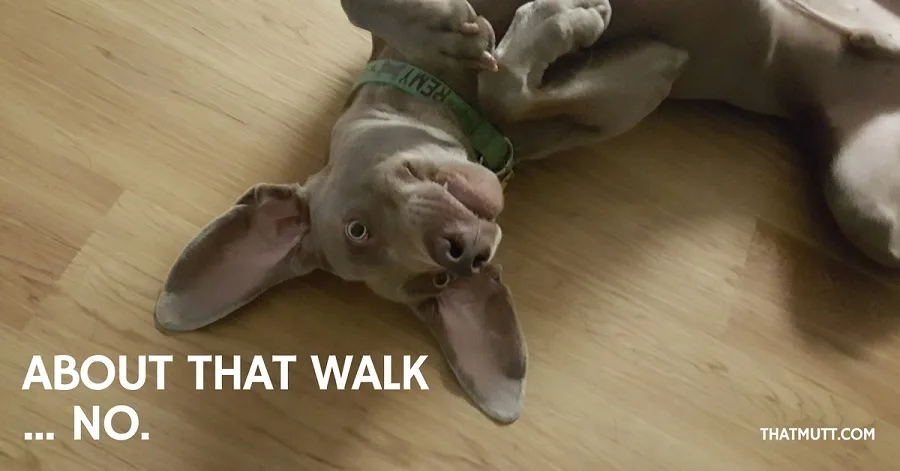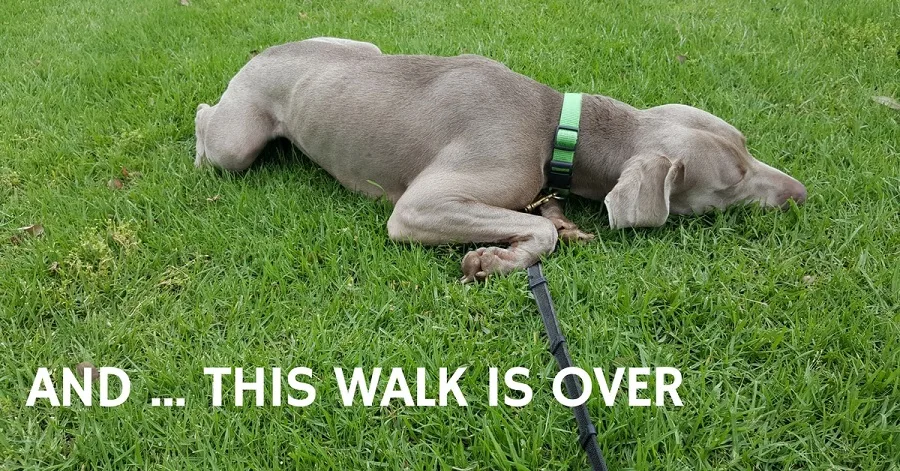This post is about what to do if your dog refuses to walk.
I’m not referring to senior dogs who might be in pain or are physically unable to walk.
This post is about dogs who just don’t want to walk because they’re scared, lazy, bored or whatever it might be.
You know, when your dog “puts on the brakes” and digs his nails in refusing to move? Or when he just flips over on his back and says “I’m done.”
Or when he keeps turning around trying to bolt back home? Those are the dogs I’m talking about.
I’ll address fearful dogs at the end of this post, but first let’s focus on dogs that are just not motivated to walk. Those dogs exist!
Here are some of my tricks. Leave yours in the comments because these discussions are helpful to dog owners in this situation.
What to do if your dog refuses to walk

1. Play with your dog.
Be silly! Run for a second to initiate chase. Do a “play bow.” Bring a rope toy or a squeaky toy. Call out, “Yeah! Good boy, Zeus! Yay!” Praise him and pet him when he follows.
If your dog “puts on the brakes” and refuses to move, try building some momentum by quickly turning around at a fast pace to go the other direction. But then, quickly turn around again so you’re heading in the original direction.
Use a happy voice, food or a toy to motivate him. “Yay! Good boy!”
2. Change your route.
Be unpredictable. Most dogs “put the brakes on” at the same spot every time – a certain corner or a certain house. So pick a different route.
It also helps to go on more of a “loop” route instead of heading to a turnaround point. If you follow a loop, you remove the habit of turning around. But choose smaller loops to start with.
3. Bring high-valued treats.
I’m talking pieces of real meat, smelly jerky treats or pieces of cheese. Hot dogs?
Be careful not to fall into the pattern of luring/bribing your dog with food every time he stops or sits. Instead, give him a surprise treat when he’s IN MOTION.
We like to use Zuke’s Mini Naturals.
Slowly increase your expectations so he has to walk a few seconds longer to get a goodie. Combine that with a really upbeat, excited voice. “Wow! What a good boy! So fast! Look at you!”
If your dog loves to use his nose, using high valued food is even better! You can drop little pieces on the ground to get him using his nose instead of focused on stopping or turning around.
Sometimes just getting their little brain to focus on a new task is all you need to break a habit.
*Don’t miss out on That Mutt’s new posts. Get my weekly training tips to your inbox: Click Here.
4. Bring a friend or family member.
My dogs think it’s 10 times more fun if Josh tags along on our walks. Have your family member walk ahead of you a bit so your dog is encouraged to catch up. Don’t worry about pulling.
For extra motivation, have the friend carry food or a toy or bring another dog along (assuming the two dogs are friends).
5. Drive somewhere more interesting.
Get out and walk there. Could be a park, a different neighborhood, the country, wherever. Only if your dog is not fearful of new places.
6. Change up your dog’s feeding schedule.
If you normally feed your dog right after your walk, it’s possible he’s trying to end the walk sooner so he can get home and eat. Consider feeding him before the walk.
Or, you might have the opposite problem. Maybe you need to use his food to motivate him for the walk. Or feed him his food DURING the walk! The point is, consider changing the routine to your benefit.
7. Re-consider the collar or harness you’re using.
Would he walk better if you used something else? Some dogs “shut down” while wearing a Gentle Leader or Halti-type collar that fits around the muzzle, for example.
While these are great to prevent pulling, sometimes they work too well!
8. Is your dog wearing a coat?
Some dogs don’t like to walk while wearing a coat, sweater, dog backpack or booties. Your dog probably doesn’t need this gear anyway.
On the other hand, a dog backpack might motivate some dogs because it gives them a “purpose” and they’re focused on their work instead of stopping or turning around. Silly dogs.
9. Don’t let your dog slip out of her collar.
Dogs that don’t want to walk or dogs that are scared are VERY good at backing out of their collars or twisting out of just about anything, including harnesses.
So pick something that fits properly and clip the leash to more than one tool if needed. For example, clip it to a harness and a collar. Sometimes using a carabiner or a second leash is helpful.
Of course, make sure your dog wears ID tags and consider a microchip for added safety.

What if your dog refuses to walk because he’s scared?
That’s more challenging but you can still try some of the tips above. Here are some additional points to consider.
1. Acknowledge your dog’s fear.
If your dog is scared, it’s important to acknowledge to yourself that your dog is truly afraid and can’t help it.
However, it’s also important not to feel sorry for him or coddle him too much. Instead, slowly build up his confidence so he can learn that walks are not so scary!
2. Give encouragement.
I find that dogs with low confidence do well with happy, verbal praise combined with slow, firm pats on the side. (Not all dogs appreciate this however.)
3. Give newly adopted dogs time to adjust.
If you just adopted the dog, make sure you’ve allowing him time to adjust to his new routine. It’s a lot to adjust to a new home, new owners, let alone a new neighborhood and town.
4. Use basic obedience to build confidence.
Work on some simple obedience or tricks at home to boost confidence. Short sessions of 5 minutes or so.
Sometimes you can fall back on an easy trick or command during a walk to get your dog motivated and confident to keep going.

5. Walk with a friend’s dog.
If she likes other dogs, walk with a friend and their dog is a great way to encourage her to go out and investigate, especially with an easygoing, happy dog.
Don’t let this backfire by pairing up with a dog that could scare her. Do slow intros, avoid direct eye contact between the dogs and head-on meetings. Walk side by side or one in front of the other first.
See my post how to introduce dogs.
6. Clicker train.
First teach your dog what the clicker means. Click = treat for doing the behavior you want. Start with something simple like sit. The dogs sits, click, instant treat.
On your walks, click and treat your dog when she’s in motion. Don’t worry if she’s pulling for now.
7. Reach out to others for ideas.
See the comments below and please leave your questions or suggestions there too because the discussion is helpful for others. Thank you!
*Don’t miss out on That Mutt’s new posts. Get my weekly training tips to your inbox: Click Here.
*This post contains affiliate links.
Additional resources:


Joanie
Tuesday 15th of January 2019
My dog lies down and refuses to move when he see’s another dog he wants to say hello to,some times this is a bit awkward as not everyone wants there dog to say hello or play. I just wait till they pass them he’s fine .
Pauline W.
Wednesday 29th of April 2020
My 5 year old shitzu maltese terrier is a rescue from a puppy mill and she has been with me for nearly three years. She has come a very long way in her development and is very quiet and affectionate and cute and adorable. She has recently developed behaviour of not wanting to walk out of our condo and down the hall and out of the building. She doesn't want to walk and I thought that she was just being stubborn and that I could encourage her , but that hasnt worked. I find that I have to pick her up and get her outside and after much encouragement she will walk. She will not take a treat from my hand but likes them when I leave them for her on the floor. Help please.
Lisa
Friday 14th of September 2018
My dog stops walking for numerous reasons. He is just sooo stubborn! He will stop because he doesn’t want to vary the routine and wants to stick to the same route; he will stop because wants to cross to the other side of the road and won’t accept no; he will stop if I walk ahead- I worked out that if I come back to being beside him, he starts again. Any of these can happen on any given day - not really predictable LOL. And I have to carry him from the dog park because he doesn’t want to leave ... who needs a gym when your dog is 20kg. :) I have tried treats and waiting it out, nothing works. I wouldn’t change him for the world though - he has character! And is super cute.
Denise
Wednesday 12th of September 2018
Miss Molly didnt know what a leash was when she first came home 2yrs ago. I started off with walking just down the street. She walks about 3 miles a day now but freezes in her tracks if another dog or sometimes a person is coming her way. I stop with her, back up a few steps, give some positive words then move on again. It seems to be working but takes patience
Lindsay Stordahl
Wednesday 12th of September 2018
Thank you for sharing your experience.
Sue
Saturday 4th of August 2018
My 13 pound terrier mix does this every single time we walk. We are in a townhouse so I can’t just let her out. I’ve tried harness and still end up pulling her. Tried treats but she’s not treat driven at all. Even if I pick her up and bring her to her “spot” she will just stand there and protest until she decides she’s ready. Very frustrating.
Rose Dunnelle
Thursday 7th of June 2018
Great advice